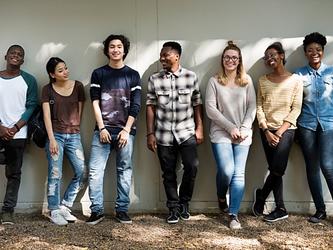The socially driven teenage brain
We’re familiar with the idea of nudging – making small changes to choices and messages to steer people to alter their behaviour for the better. This is based on insights from behavioural science, which show how we’re all affected to some degree by subconscious cognitive biases and by different contexts.
What’s fascinating is that scientists are now beginning to understand how our susceptibility to certain biases changes throughout our life – from childhood to old age. As recently as 20 years ago, scientists assumed that most of our brain’s development was completed by mid to late childhood. In fact, through improvements in brain-imaging technologies, we now know that huge amounts of development – remodelling and strengthening some connections while pruning others – continue throughout childhood and adolescence. Our brains have not fully matured until we are in our mid-20s.
Many experts believe this is a period of adaptation, rather than maturation, though. It’s a time for teens to bed down their own identity and achieve the things they need at that point in their life, such as forming strong relationships with their own generation, and moving away from the safety of home and out into society.
This latest research helps us to understand different behavioural tendencies across age groups. It suggests we may be more affected by certain cognitive biases at certain times of our lives. So, if you’re working in behaviour change, or designing nudges, it may be better to tailor your interventions according to age.
Looking at some of the key findings in the latest research on adolescents, it’s probably no surprise that research shows teenagers, the world over, are driven by – and highly sensitive to – peers’ interactions and relationships. But the ‘why’ is intriguing. It’s because their brains are highly sensitive to rewards, particularly social rewards. Evolutionarily, it helps them to forge their own way in life and develop strong connections with the upcoming generation that’s on its way in, rather than their parents’ generation, which is on its way out.
Adolescents are hypersensitive to being excluded and rejected by their peers, and get far more anxious and moodier than a typical adult.
This drive to be accepted and included can often be the cause of risky behaviours. It’s not that teenagers underestimate risk – research shows they are capable of evaluating a risk as well as an adult and, on occasions, are more risk-averse than adults. It’s just that they deem a risk worth taking if there could be a social reward.
This means they often choose more risky behaviour when among their peers. For example, statistics show that younger people are far more likely to have a car accident when they have a passenger in the vehicle, whereas it’s the reverse for adults. This is because the risks don’t need to be physically dangerous for adolescents to see them as a risk.
Neuroscientist and expert on the teenage brain Sarah-Jayne Blakemore says adolescents see social risks as salient, too. In the heat of the moment, getting teased for driving safely and steadily may be weighed as a bigger risk than the chance of crashing.
Other perceived social risks might be asking someone on a date, not conforming to the latest style trends, or standing up for a friend.
Yet the very latest research is also demonstrating that peer influence can drive more positive behaviours and outcomes – such as learning, exploration and prosocial behaviour, like volunteering.
A 2015 study by Choukas-Bradley et al, published in the Journal of Youth Adolescence, asked American schoolchildren aged 12-14 how likely they were to volunteer in different activities, such as helping to raise money for a community centre by participating in a car wash, or tutoring at an elementary school. If they were additionally aware that a popular and well-liked peer – signalled in the experiment by being friends with other cool kids and doing hobbies typically associated with high status – was very likely to volunteer, the children were more likely to say they would participate, too, particularly in public. But they also stated it in private, showing they had assimilated the norm.
From a behavioural science perspective, these new insights mean we can better tailor behavioural interventions to this age group. Messages informing them about peer behaviour, or from a popular or authoritative peer figure, are likely to be more effective and influential.
For example, a 2016 study by Paluck, Shepherd and Aronow, looking at which programmes reduced bullying and conflict in New Jersey schools, found that they tended to be most successful when more popular and highly connected pupils were involved in the campaign.
Implications
- Behavioural-change interventions are likely to be more effective if tailored and personalised towards different age groups
- Initiatives that draw on adolescent impulsiveness in search of a reward – or that use peer influence, particularly of popular, high-status peers – may be more effective
- Considering the context in which teenagers may be deciding could be key – are they alone or among peers?
- How information is framed could be crucial – highlighting the rewards is likely to be more effective than drawing attention to the downsides.
This article was first published in Issue 23 of Impact.

We hope you enjoyed this article.
Research Live is published by MRS.
The Market Research Society (MRS) exists to promote and protect the research sector, showcasing how research delivers impact for businesses and government.
Members of MRS enjoy many benefits including tailoured policy guidance, discounts on training and conferences, and access to member-only content.
For example, there's an archive of winning case studies from over a decade of MRS Awards.
Find out more about the benefits of joining MRS here.














0 Comments